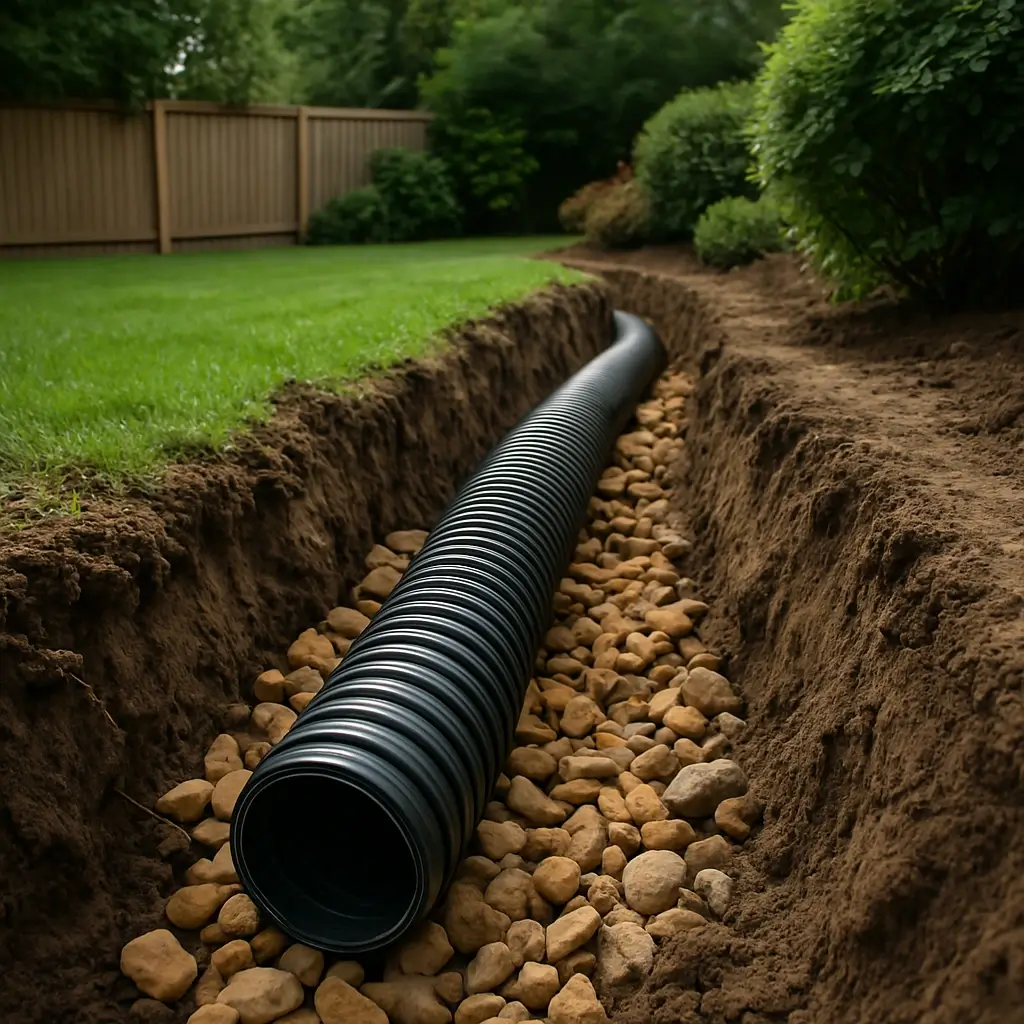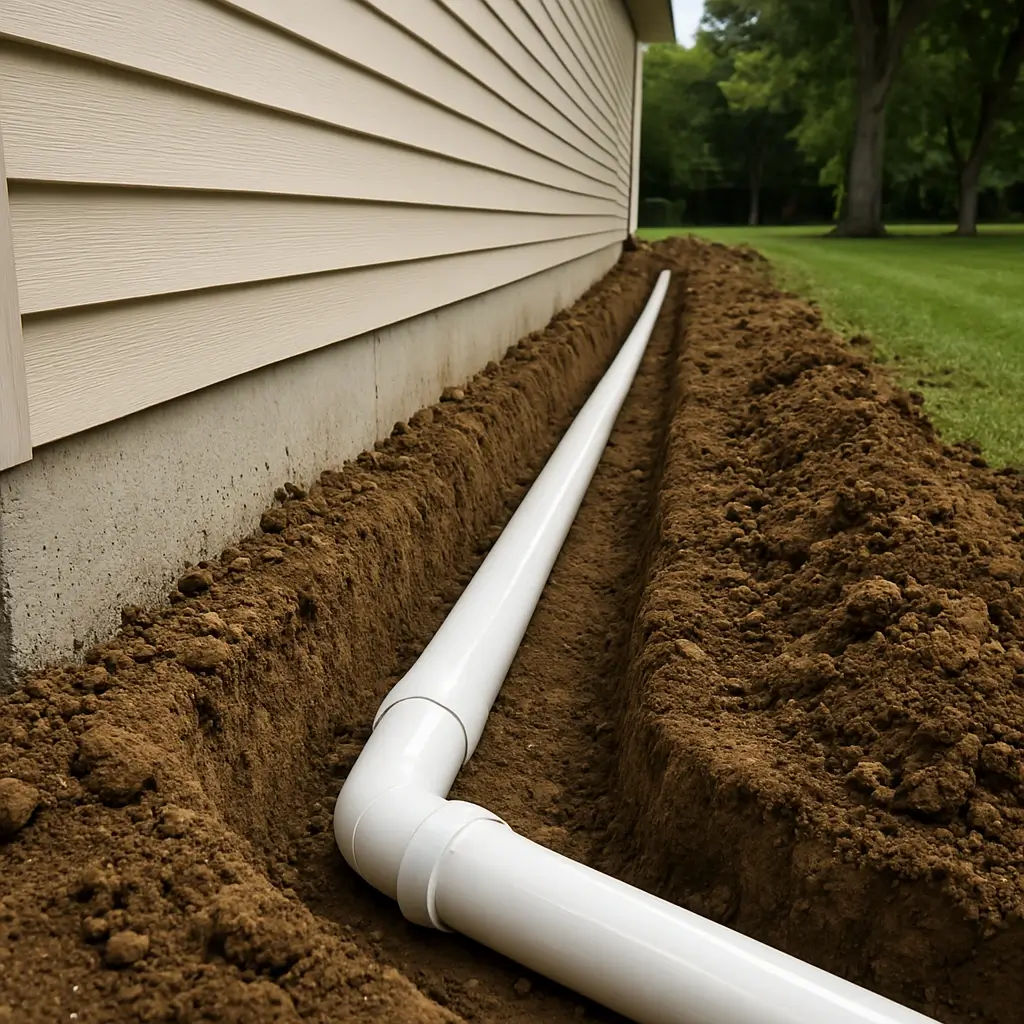Quiet Protection, Right Below the Surface
Underground Drainage—Supporting the Natural Flow of Water
Water is meant to move—not sit. Our underground drainage systems help support that natural flow, guiding rainwater safely away from your home or building. It’s a quiet, effective way to protect your foundation, preserve your landscaping, and prevent future issues before they begin.
Built to Protect from the Ground Up
Helping Your Property Breathe Easy After Every Storm
When water doesn’t have a place to go, it finds one—often where it shouldn’t. Underground drainage gives that water a better path, working quietly beneath the surface to protect what’s above. Whether it’s your lawn, your landscaping, or your foundation, it all benefits from better flow.
Key Benefits of Underground Drainage
Prevents Standing Water – Excess water is moved underground and away from the surface, keeping your yard from turning into a soggy mess after every rain.
Protects Foundations – By guiding water away from your home or building, underground drainage helps reduce the risk of cracks, shifting, or seepage over time.
Preserves Landscaping – From flower beds to decorative gravel, your landscape stays where it belongs—no more washouts after a heavy downpour.
Improves Water Flow – These systems work with your property’s natural slope to keep water moving and avoid backups or overflow near gutters and downspouts.
Reduces Erosion – When rainwater flows freely across a yard or slope, it slowly takes soil with it. Underground drainage helps keep soil in place where it’s needed most.
Stays Out of Sight – Because it’s buried, you get all the protection without any visible equipment—your yard looks clean, uninterrupted, and fully usable.
Have a Question?
Shaped by the land
Materials We Use With Your Property in Mind
The materials we choose depend on your property—its layout, grading, and how water tends to collect or move across it. Whether it’s flexible pipe that curves through a sloped yard or rigid PVC for structure and support, each component plays a role in helping water go where it should, quietly and efficiently.
So Which Type of Drainage is Right for Your Property?
It depends on a few key things—like grading, soil type, and where the water collects. Some systems are designed to carry water further, others let it soak into the ground slowly. Here’s a closer look at the options we use most often.
French Drains
If water tends to settle in one area of your yard—or near your home’s foundation—a French drain offers a smart, long-term fix. It works by collecting water through a gravel-lined trench and redirecting it through a pipe buried below. The pipe is perforated and wrapped in fabric to help filter debris while allowing water to pass through.
Depending on the installation that’s right for you and your property, a French drain can be buried and nearly invisible, or finished with decorative gravel for a purposeful look that can complement your landscaping.
Where It Works Best
Great for low spots, saturated soil, or areas where water consistently pools after a rain. It’s especially useful near foundations, patios, or the base of slopes where drainage is often a problem.

Corrugated Flex Pipe
Corrugated flex pipe is lightweight, flexible, and designed to move water around obstacles that rigid pipe can’t easily navigate.
It’s a good fit for areas where the yard has curves, slopes, or landscaping that needs to be worked around. While it’s not as strong as PVC, it’s ideal for shallow installs and lighter-duty drainage setups where adaptability matters more than rigidity.
Where It Works Best
Commonly used for downspout extensions, garden beds, and tight spots where water needs to be redirected without a straight run. A practical option for residential yards with limited depth or a winding layout.

PVC Drainage Pipe
PVC is strong, rigid, and built for the long haul. It’s commonly used in underground drainage when the system needs to carry water over longer distances or through areas that see heavier traffic—like under driveways or along commercial buildings.
Unlike corrugated pipe, PVC doesn’t flex, which makes it ideal for straight runs where structure and durability are the priority.
Where It Works Best
Great for structured drainage systems with long, straight sections. Often used in commercial settings, under hardscapes, or anywhere a heavy-duty solution is needed.

Built for Oklahoma's weather
Underground Drainage—Thoughtfully Planned
Easy next steps
Your Drainage Solution Starts Here
Step 1
Schedule Appointment
Give us a call or send a message to schedule your appointment. We’ll work with you to find a time that fits your schedule.
Step 2
On-Site Assessment
We walk the property with you and listen. Before we recommend anything, we take the time to understand your concerns, check for drainage patterns, and talk through the right options for your property.
Step 3
Custom Plan & Quote
Designed for your property’s needs. We’ll map out the best drainage solution for your home or building and provide a clear, detailed quote so you know exactly what’s ahead.
Step 4
Installation Day
Our team handles the heavy lifting. We show up on time, respect your property, and install your drainage system with care — keeping disruption minimal and quality high.
Fixing Drainage Problems at the Source
Protecting & Safeguarding Your Property
Drainage issues can lead to pooling water, soggy landscapes, and long-term property damage, whether at home or in your business. Addressing the problem at its source ensures water flows where it should, protecting your property, your investment, and your landscape for years to come.
Common Problems We Solve
Pooling Water Around Your Foundation – Water that doesn’t drain away from your home or property can accumulate around your foundation, leading to potential structural issues.
Soggy Lawns and Landscape – Standing water in your yard can damage your landscaping, create muddy patches, and even encourage mold or mildew growth.
Flooded Driveways and Parking Areas – Without proper drainage, rainwater can pool on driveways or parking lots, creating hazards and causing long-term damage to the surface.
Erosion of Soil and Landscape Features – Improper drainage can wash away topsoil, leaving bare patches in your yard or around your building, affecting plant growth and overall property appearance.
Damaged Pathways and Retaining Walls – Excessive water runoff can erode pathways or weaken retaining walls, leading to cracks, instability, and costly repairs.
Low-Maintenance Drainage
Simple Checks—Long Term Performance
Underground drainage systems are designed to be low-maintenance, handling water flow efficiently with minimal intervention. Once installed, they require very little upkeep, allowing you to focus on other priorities. A few simple checks during storm season and after heavy rains are all it takes to ensure everything is functioning as it should.
Check Outlet Areas
After storms, check the outlet areas to make sure water is flowing away from your property.
Check for Blockages
Occasionally inspect the visible outlet areas for any debris or obstructions that could interfere with water flow.
Observe Water Flow
Ensure that water flows in the right direction and away from your foundation or landscaping.
Let Us Know
If you see something that doesn’t look right or simply have a question, give us a call.
FAQs
Have Questions? We’ve Got Answers
How does an underground drainage system help protect my property?
Underground drainage systems move water away from homes, businesses, foundations, and landscaped areas. By redirecting runoff below the surface, they help prevent flooding, soil erosion, and water damage, keeping both residential and commercial properties protected.
What type of underground drainage system is best for my property?
It depends on the size, layout, and specific needs of your property. French drains work well for controlling groundwater, corrugated flex pipes are great for flexible routing around obstacles, and PVC systems offer strong, long-lasting solutions. We assess each property individually—whether residential or commercial—to recommend the best fit.
Do underground drainage systems require a lot of maintenance?
No, they are designed to be low maintenance. Once installed, they manage water efficiently with little effort needed. A simple seasonal check after heavy rains or during storm season helps ensure everything is working properly at the outlet points.
How long do underground drainage systems last?
When installed correctly, underground drainage systems can last for decades. Both residential and commercial systems built with quality materials like PVC and properly installed French drains are designed to handle heavy water flow and resist wear over time.
Can underground drainage help with pooling water on my property?
Yes. Whether it’s a soggy yard at home or water collecting around a commercial building, underground drainage systems are designed to move water away from problem areas, protecting landscaping, foundations, and paved surfaces.

Make an appointment
Get a quote today
Call us

